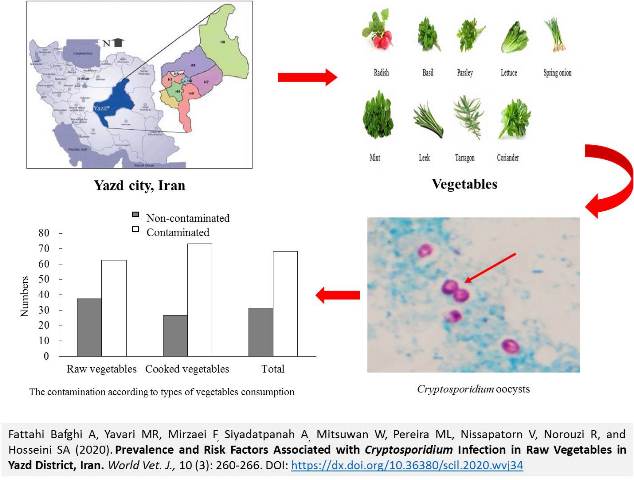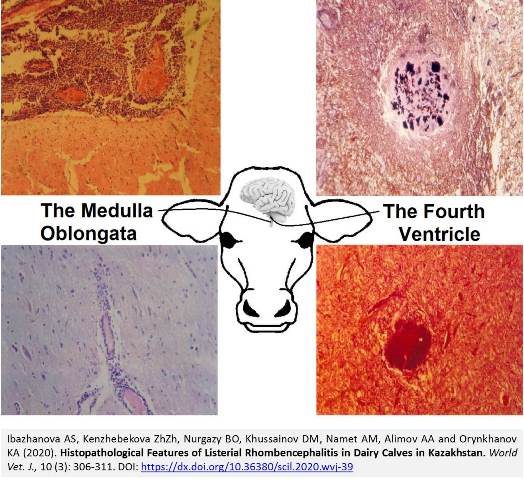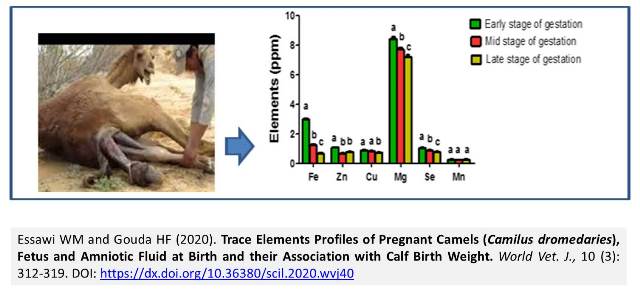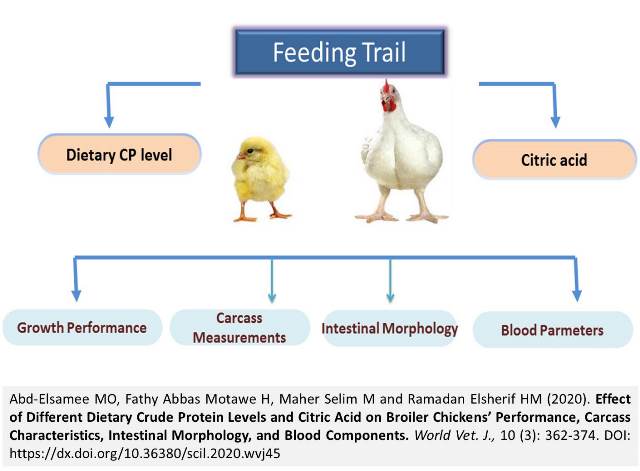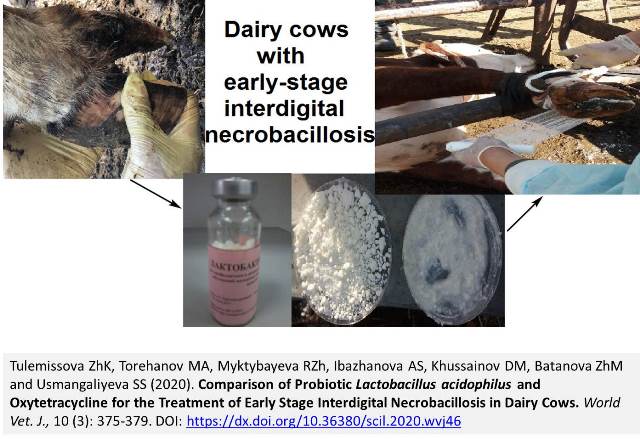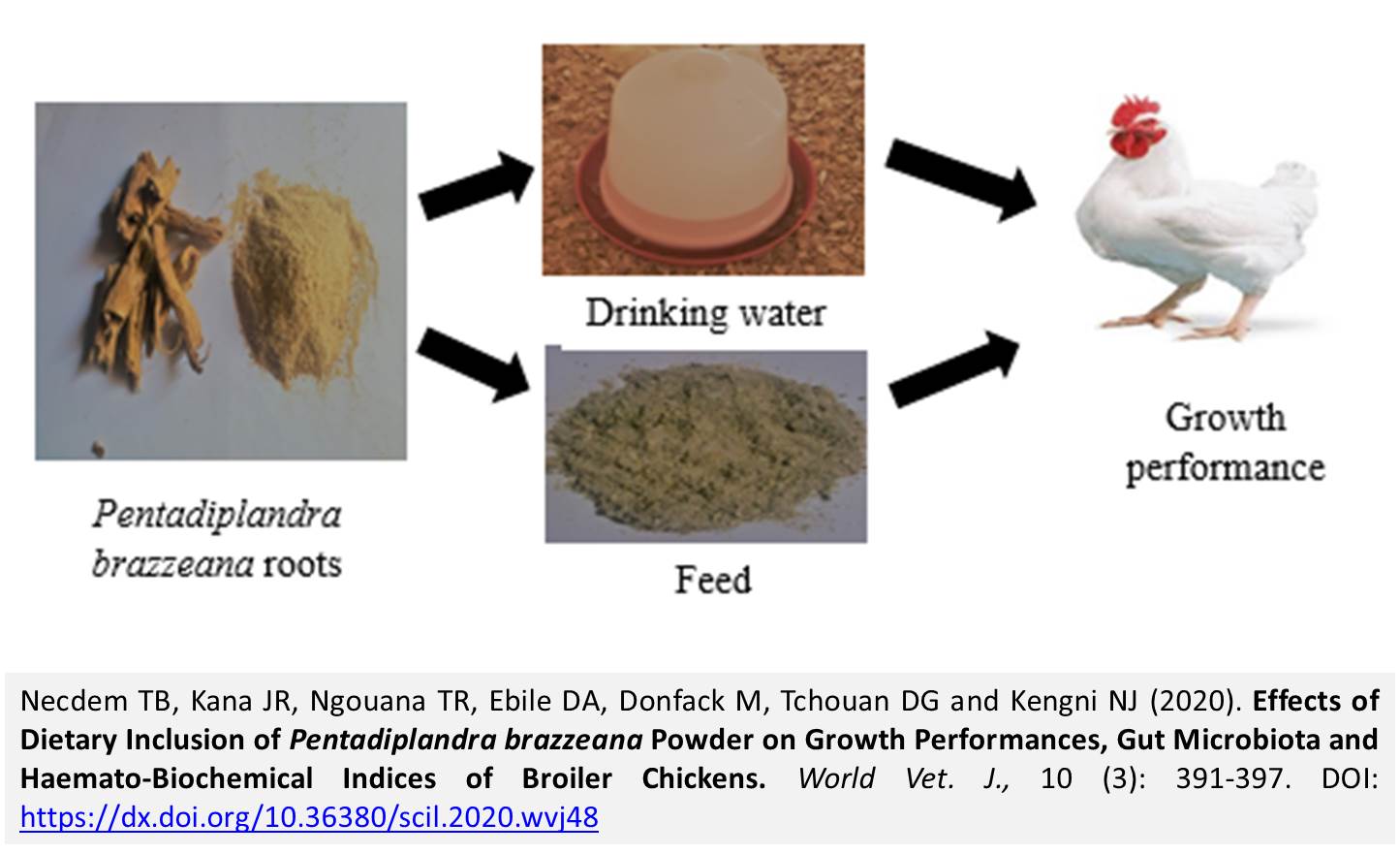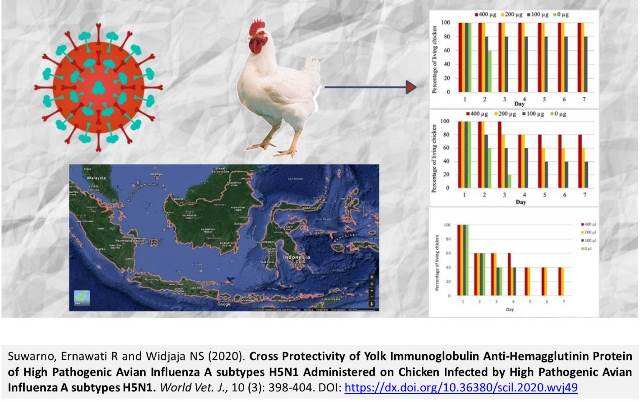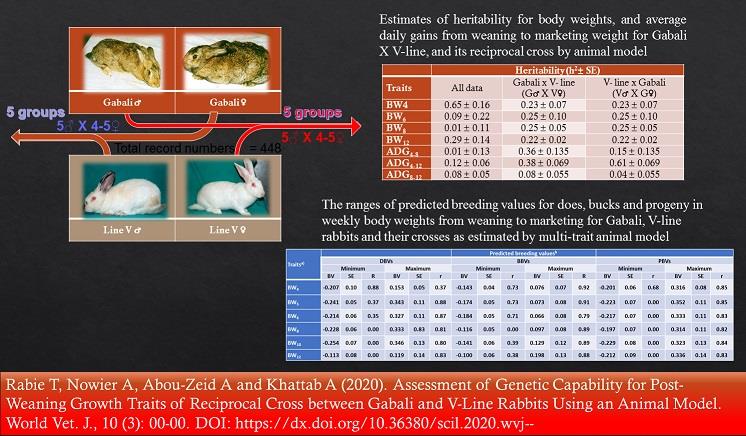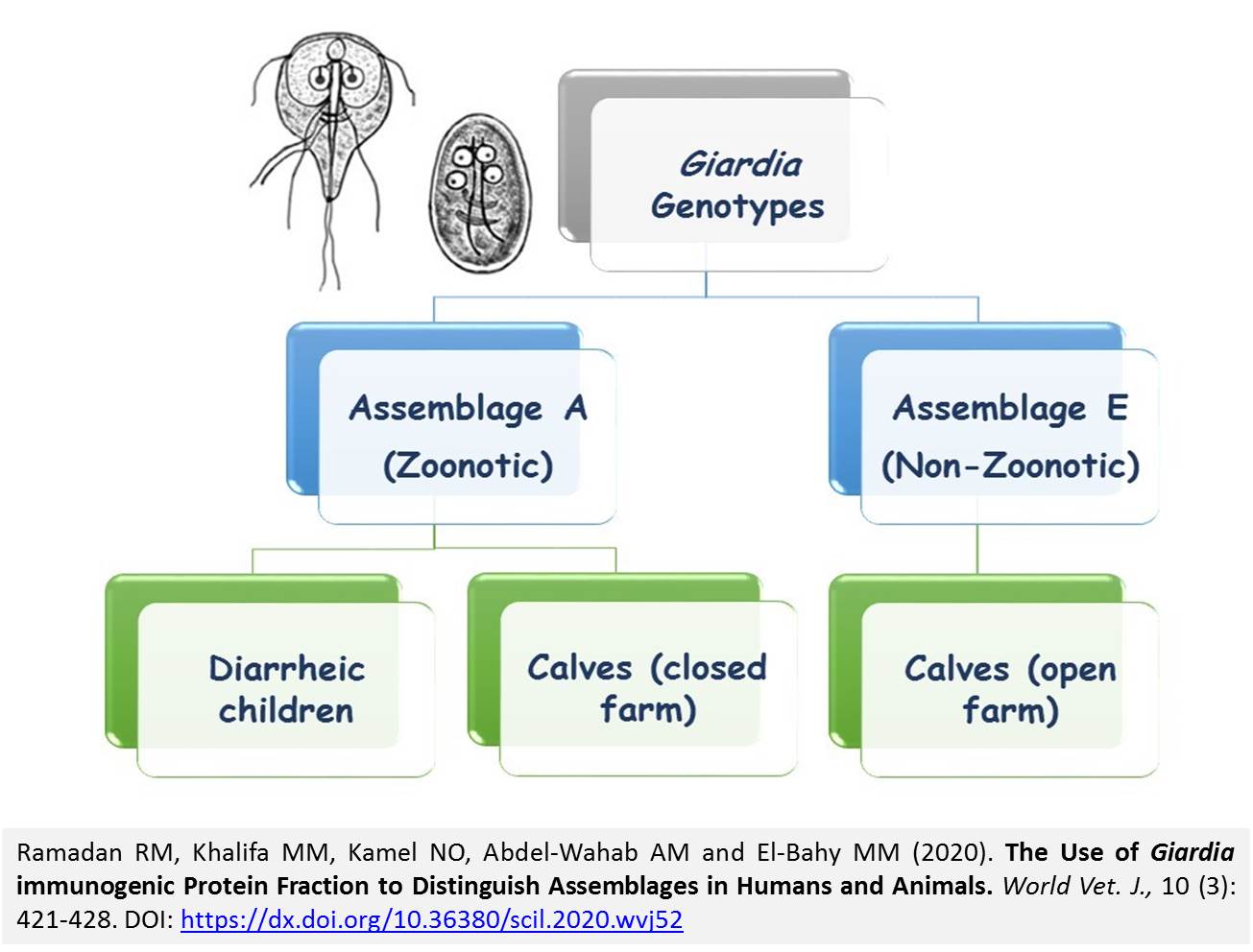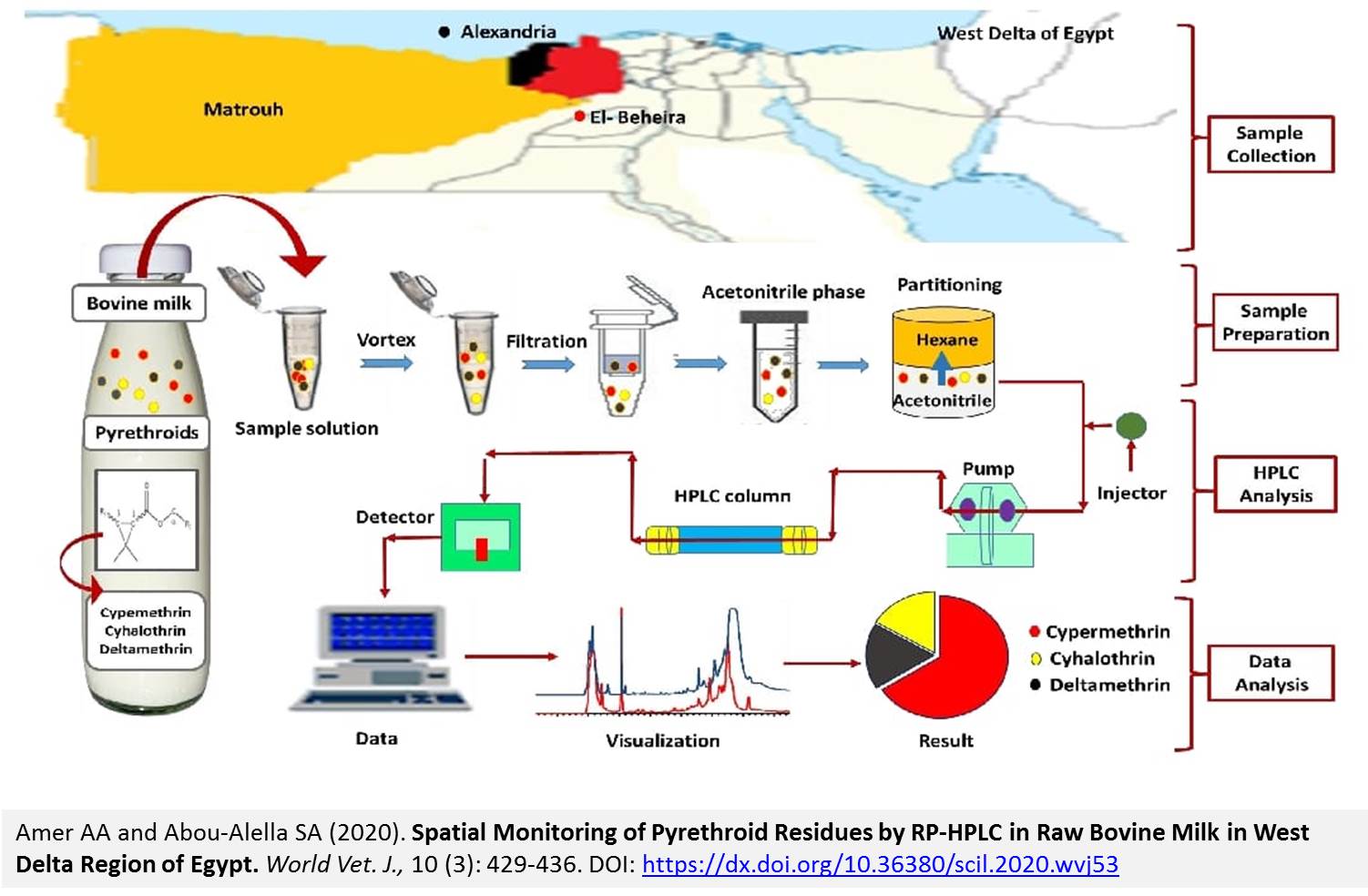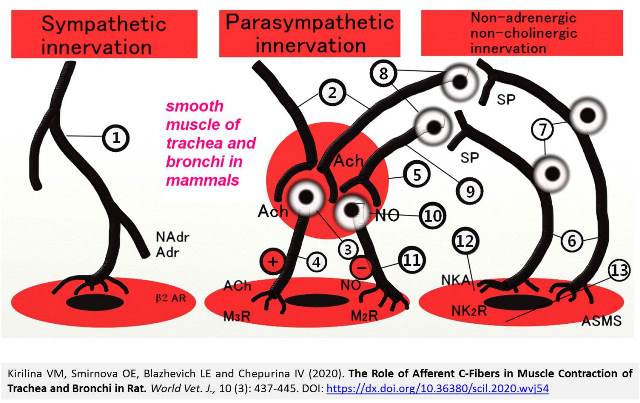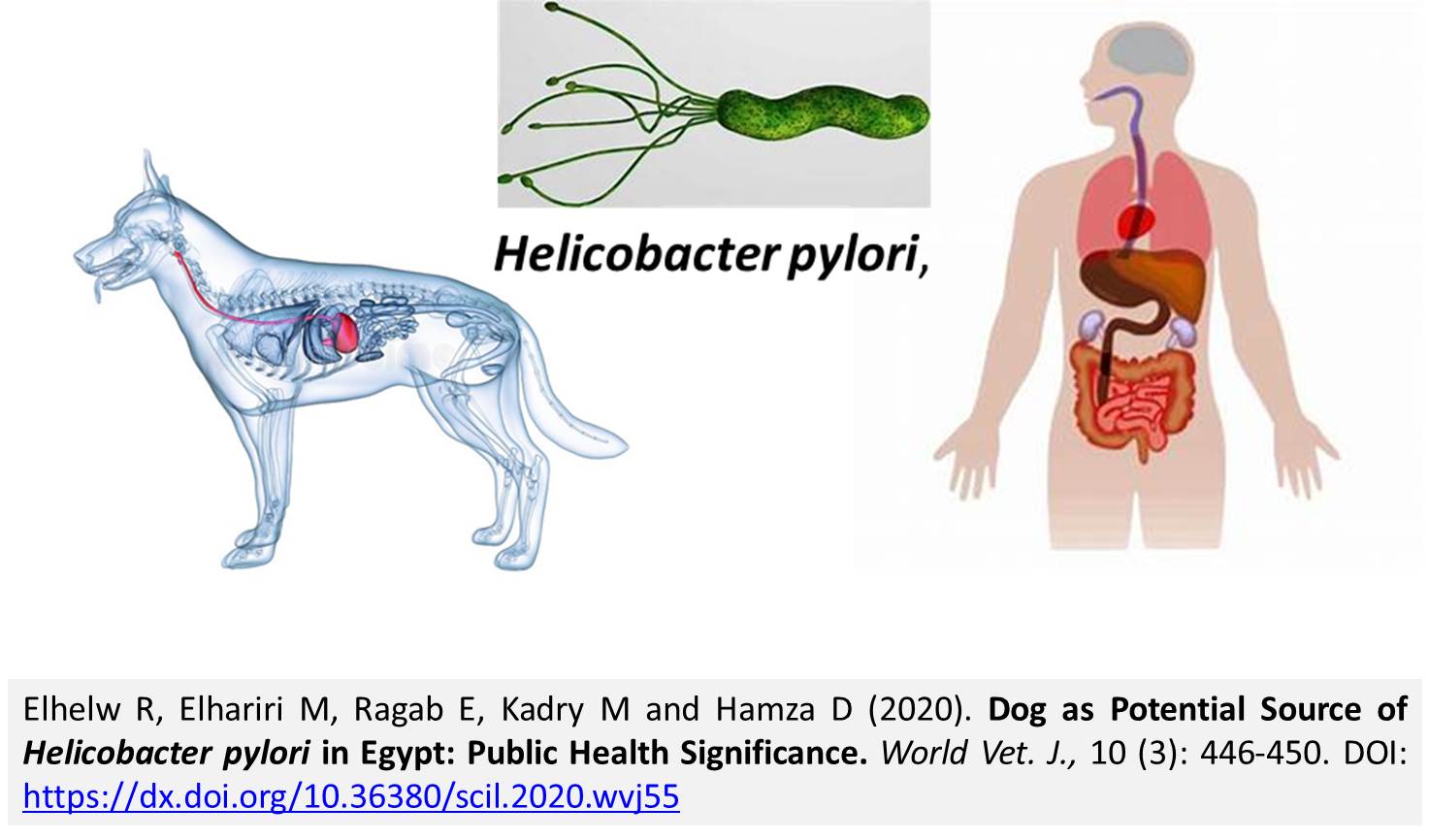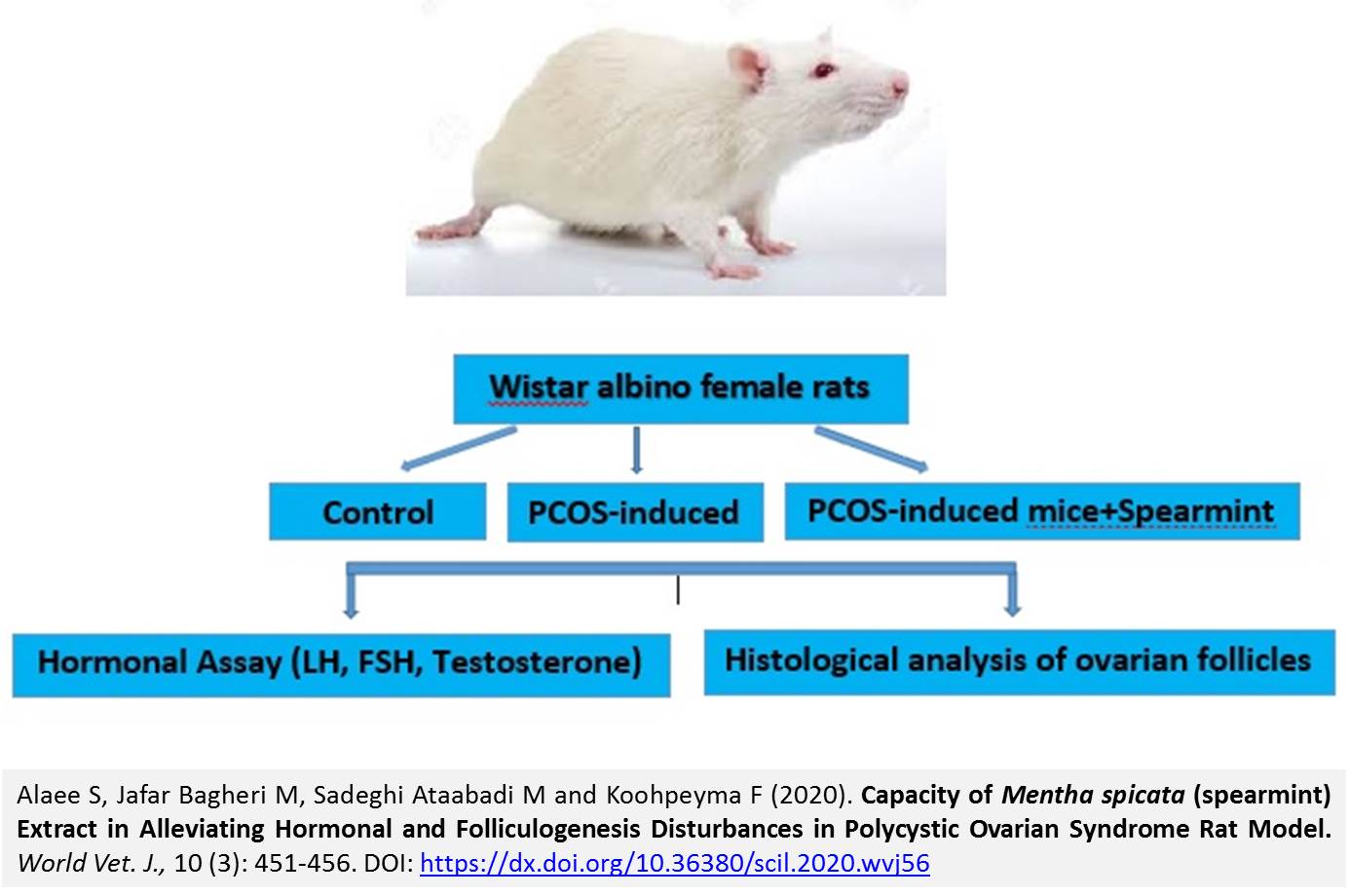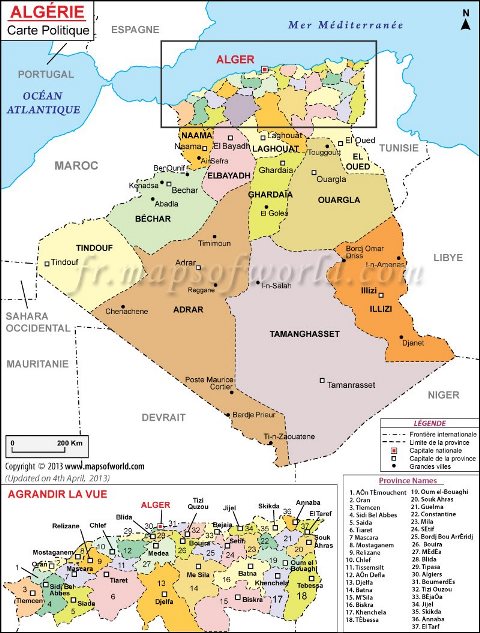Previous issue | Next issue | Archive
![]() Volume 10 (3); September 25, 2020 [Booklet] [EndNote XML for Agris]
Volume 10 (3); September 25, 2020 [Booklet] [EndNote XML for Agris]
Prevalence and Risk Factors Associated with Cryptosporidium Infection in Raw Vegetables in Yazd District, Iran
Fattahi Bafghi A, Yavari MR, Mirzaei F, Siyadatpanah A, Mitsuwan W, Pereira ML, Nissapatorn V, Norouzi R, and Hosseini SA.
World Vet. J. 10(3): 260-266, 2020; pii:S232245682000034-10 ; DOI: https://dx.doi.org/10.36380/scil.2020.wvj34
ABSTRACT
Consumption of raw vegetables is an important route of parasites transmission. It is an important source for foodborne outbreaks in both developed and developing countries, and outbreaks of parasitic diseases in humans. The objective of the present study was to detect the presence of Cryptosporidium oocysts in raw fresh vegetables in Yazd city, Iran, from 2017 to 2018. A total of 275 fresh vegetable samples were collected and tested using a sucrose flotation medium of 1.21 specific gravity and a Modified Ziehl-Nielsen staining procedure. Of the 275 vegetables examined, 85 (31.5%) samples were positive for Cryptosporidium oocysts. Lettuce had the highest rate (n= 16, 47.1%) of contamination with Cryptosporidium oocysts while basil and parsley showed the lowest rates of contamination (n= 6, 20%). There was a significant association between the occurrence of Cryptosporidium oocysts and the investigated vegetable types. According to the locations of the vegetable field, Amir Abad and Bahaman Hospital area had the highest (n: 16, 59.3%) and lowest (n= 5, 18.5%) rates of Cryptosporidium oocysts contamination, respectively. The plant part showed that the root vegetables had the highest contamination rates (n= 41, 45.6%), followed by leafy vegetables (n= 44, 24.4%). The analysis further indicated a significant association between the occurrence of Cryptosporidium oocysts and the route of vegetable consumption. Based on these results, the edible vegetables in Yazd city are one of the potential sources of Cryptosporidium infections in humans. Moreover, the vegetable fields within the city of Yazd are contaminated with Cryptosporidium oocysts which can pose public health problems.
Keywords: Cryptosporidium, Oocysts, Raw vegetables, Yazd city, Iran.
[Full text-PDF] [XML] [Google Scholar] [Crossref Metadata] [Scopus] [Export from ePrint] [How to Cite]
Antibacterial Efficacy of Zinc Oxide and Titanium Dioxide Nanoparticles against Escherichia coli in Minced Meat
Abd El-Aziz M.A., Ibrahim H.M., EL-Roos NA, Anis B and Elsabagh R.
World Vet. J. 10(3): 267-275, 2020; pii:S232245682000035-10; DOI: https://dx.doi.org/10.36380/scil.2020.wvj35
ABSTRACT
Antibacterial nanoparticles are a new approach to control the safety of meat and meat products. This work aimed to investigate the antibacterial effect of zinc oxide (ZnO) and titanium dioxide (TiO2) nanoparticles, alone or together, against Escherichia coli. Antibacterial activity of these nanomaterials was evaluated using the disc diffusion method. In this regard, minced meat samples were inoculated with E. coli and treated with different concentrations of two nanomaterials (approximately 20 nm), including 6 mM and 12 mM ZnO, 6 mM and 12 mM TiO2, and a combination of 6 mM ZnO and 6 mM TiO2, then stored at 4°C for 17 days. The results indicated that ZnO (12 mM) had a significant reduction effect on E. coli count in minced meat, followed by the combination of ZnO and TiO2, and 12 mM TiO2 alone. The antibacterial activity of ZnO, TiO2, and combination of ZnO and TiO2 was also examined using a transmission electron microscope and it was found that 12Mm ZnO had a higher destructive effect on bacterial cell than the mixture of ZnO + TiO2, and 12Mm TiO2 alone. The disc diffusion method showed that ZnO (12 mM) was the most effective concentration used against E. coli. It is concluded that 12 mM ZnO nanoparticles have the best antibacterial effect against E. coli in minced meat stored at 4 °C for 17 days.
Keywords: E. coli, Minced meat, Nanoparticles, TEM, Titanium dioxide, Zinc oxide.
[Full text-PDF] [XML] [Google Scholar] [Crossref Metadata] [Scopus] [Export from ePrint] [How to Cite]
Incidence and Prevalence of Hard Ticks in Ruminants of Al-Ahsa Oasis Region, Kingdom of Saudi Arabia
Abdally MH, Al-Marri TM, Abdally HM and Al-Jabr OA.
World Vet. J. 10(3): 276-285, 2020; pii:S232245682000036-10; DOI: https://dx.doi.org/10.36380/scil.2020.wvj36
ABSTRACT
In the present study, a number of camels, cattle, sheep, and goat herds have been examined and followed up to record the incidence of tick infestation in Al-Ahsa Oasis in the Eastern Region of the Kingdom of Saudi Arabia. From 24 herds distributed in eleven localities, a total of 4068 animals (123 camels, 60 cattle, 1780 sheep, and 2105 goats) were individually examined every second week during the period from January to December 2010. In total, 5320 ticks were collected from 1125 infested animals (27.65%). The overall prevalence rate of identified Ixodide ticks was: Hyalomma anatolicum excavatum (18.33%), Hyalomma dromedarii (17.63%), Hyalomma anatolicum anatolicum (14.29%), Rhipicephalus turanicus (14.04%), Hyalomma impeltatum (11.28%), Rhipicephalus praetextatus (8.56%), Hyalomma marginatum turanicum (6.20%), Haemaphysalis sulcata (3.57%), Rhipicephalus kohlsi (2.33%), Hyalomma marginatum rufipes (2.09%), Hyalomma schulzei (1.03%), Amblyomma variegatum (0.47%), and Amblyomma gemma (0.18%). Tick infestation in terms of mean intensity, abundance, and prevalence rates was highest in camels (41 tick/infested camel, 30 ticks/camel, and 73.17%, respectively). This was followed by cattle (15 tick/infested cow, 5 ticks/cow, and 33.33%, respectively), goats (1.35 tick/infested goat, 0.33 tick/goat, and 23.52%, respectively), and sheep (1.27 tick/infested sheep, 0.3 tick/sheep, and 29.21%, respectively). The incidence rate of ticks significantly increased during the warmest summer months of the year (highest recorded temperature ranged between 47℃ and 50℃), mainly due to the management practices of farmers. During this period animals were housed and water was supplied ad libitum during hot months, thereby increasing animal density and humidity in the shaded farms. According to the obtained results of the current study, tick control can be started in Al-Ahsa area in early May for all animals with the focus on camels as they are the harbor of the tick biomass, or on goats as they had initially increased in incidence rates.
Keywords: Kingdom of Saudi Arabia, Prevalence, Ruminants, Ticks.
[Full text-PDF] [XML] [Google Scholar] [Crossref Metadata] [Scopus] [Export from ePrint] [How to Cite]
Rapid Detection of Streptococci in Cultured Tilapia Fish Using PCR and Chemical Analysis
Ali GIE, Abd El-Hady HAM, and Abou Zeid MAM.
World Vet. J. 10(3): 286-296, 2020; pii:S232245682000037-10; DOI: https://dx.doi.org/10.36380/scil.2020.wvj37
ABSTRACT
Streptococcosis causes economic losses due to the high mortality in Nile tilapia (Oreochromis niloticus). The present study was carried out to detect the streptococci by PCR and chemical analysis in cultured tilapia fish. A total of 100 cultured tilapia fishes and 20 water samples were collected from 4 different fish farms at different locations in Kafr El-sheikh Governorate for bacteriological and chemical analysis. The results of water quality parameters examination revealed that the mean values of pH, dissolved oxygen, unionized ammonia, and nitrite were 8.2 ± 0.73, 7.44 ± 0.54 parts per million (ppm), 0.05 ± 0.008 ppm, and 0.00 ppm, respectively. All water quality parameters except for ammonia were within the permissible limit. The bacterial isolation results revealed 38 % positive samples for Streptococcus species isolated from tilapia fishes and 40 % were positive for Streptococcus species isolated from water samples. Of those 38 positive fish samples, 25 (65.78%) were Enterococcus faecalis, 15 (39.47%) were Streptococcus pyogenes, 6 (15.78%) were Enterococcus faecium, 5 (13.15 %) were Streptococcus agalactiae, and 3 (7.89 %) were Streptococcus iniae. On the other hand, from 8 positive farms water samples, 7 (87.5%) were Enterococcus faecalis, 2 (25%) were Streptococcus pyogenes , 2 (25%) were Enterococcus faecium, 3 (37.5%) were Streptococcus agalactiae, and 1 (12.5%) was Streptococcus iniae . Using mPCR to identify Streptococcus for some fish and water isolates, 6 Enterococcus faecalis with 310 base per (bp) were detected while 3 Streptococcus agalactiae with 153 bp and 2 Enterococcus faecium at 215 bp were detected. However, the mPCR from Streptococcus species directly from organs from fish and water samples revealed that 5 Enterococcus faecalis were detected at 310 bp while 2 Streptococcus agalactiae was identified at 153 bp. The biochemical results indicated that the infected fish with the streptococcal species had reduced total protein, albumin, and globulin in the blood serum while total cholesterol, urea, creatinine levels, and AST, ALT, GPX, CAT, SOD activities significantly increased, compared to non- infected fish.
Keywords: Biochemical parameters, PCR, streptococci, Tilapia fish, Water examination.
[Full text-PDF] [XML] [Google Scholar] [Crossref Metadata] [Scopus] [Export from ePrint] [How to Cite]
Contribution of Veterinary Sector to Control COVID-19 Pandemic in Nepal
Gautam A, Khanal A, Subedi D, Bhandari S and Kaphle K.
World Vet. J. 10(3): 297-305, 2020; pii:S232245682000038-10; DOI: https://dx.doi.org/10.36380/scil.2020.wvj38
ABSTRACT
Nepal has been identified in a high-risk zone by the World Health Organization (WHO) for the Corona Virus Disease of 2019 (COVID-19). Nepal’s first official reported case was confirmed on 13 January 2020 and so far, 24,000 cases have tested positive with 91 deaths. The imposition of lockdown has begun since March 24 and it was extended until 22 July. Reverse transcriptase Polymerase Chain Reaction and rapid diagnostic tests are used by the Government of Nepal to identify COVID-19. Among the worst-hit sectors are tourism as well as travel and the farming industries, the later contributes to the employment of around 65% of the population and a significant share of the national economy. The loss of commercial sectors, such as dairy, feed, and poultry industries are estimated to be in billions of rupees. One shortcoming of resource poorly managed countries, such as Nepal is the lack of interdisciplinary coordination. Over half a decade long professional existence and crucial contributions in Nepal’s overall development, veterinarians are just beginning to be recognized as essential service providers. Since veterinarians of Nepal have the experience of eradicating cattle plague dealing with Avian Influenza and Swine Flu among others, they study and seem to be mentally prepared to handle pandemics. Currently, five veterinary diseases diagnostic laboratories with RT-PCR facilities are serving as COVID-19 diagnosis labs. Veterinarians from Nepal are serving in innovating newer tools as well as performing, supervising, evaluating, reporting diagnosis, and actively in pursuit of establishing the One Health (OH) approach. The sincere and patriotic role played by veterinarians has pressurized the government of Nepal to recognize veterinary service as an essential commodity. In this regard, universities should take the lead and bring veterinarians in policy and planning as well as decision making. The Tribhuvan University is responsible to have the initiative and Agriculture and Forestry University to deliver the missed opportunities. The 17 sustainable development goals that are to be achieved by 2030 are not possible without a multi-sectoral approach and veterinarians are best suited in this regard. It also needs to be realized that veterinarians are better positioned to handle emerging and re-emerging zoonotic diseases and capable of combating the present situation of COVID19 pandemics. Reiterating the fact that OH approach should not only be in paper and there is no alternative but combined utilization of scarce resources for healthy animals, humans, and the environment with the veterinary profession at its core.
Keywords: COVID-19, Essential services, One Health, SARS-CoV-2, Veterinary.
[Full text-PDF] [XML] [Google Scholar] [Crossref Metadata] [Scopus] [Export from ePrint] [How to Cite]
Histopathological Features of Listerial Rhombencephalitis in Dairy Calves in Kazakhstan
Ibazhanova AS, Kenzhebekova ZhZh, Nurgazy BO, Khussainov DM, Namet AM, Alimov AA and Orynkhanov KA.
World Vet. J. 10(3): 306-311, 2020; pii:S232245682000039-10; DOI: https://dx.doi.org/10.36380/scil.2020.wvj39
ABSTRACT
Listeriosis is an infectious disease with zoonotic potential and can cause high fatality rates in animals and humans. Although the available evidence demonstrates the significance of post-mortem histological evaluation in the appropriate diagnosis, there is no sufficient evidence addressing histopathological alterations observed in calves clinically suspected of listeriosis. The current study aimed to carry out a post-mortem analysis of the dairy calves with clinical suspicion of listeriosis and determine a condition that contributed to death using histopathological evaluation. The tissue samples were obtained from 16 dairy calves with the age range of one day to one month, which died presumably due to listeriosis on several livestock farms in the Almaty region of Kazakhstan. The calves had symptoms of neurologic dysfunction prior to death. Necropsy and collection of brain histological specimens were performed, followed by procedures of fixation, dehydration, paraffinization, sectioning, staining with hematoxylin, and eosin along with Levaditi’s method, and the microscopic examination. The histopathology findings were consistent with infection by Listeria monocytogenes and localized to the brainstem leading to the diagnosis of listerial rhombencephalitis.
Keywords: Brain, Calves, Histopathology, Listeria monocytogenes, Listeriosis, Rhombencephalitis.
[Full text-PDF] [XML] [Google Scholar] [Crossref Metadata] [Scopus] [Export from ePrint] [How to Cite]
Trace Elements Profiles of Pregnant Camels (Camilus dromedaries), Fetus and Amniotic Fluid at Birth and their Association with Calf Birth Weight
Essawi WM and Gouda HF.
World Vet. J. 10(3): 312-319, 2020; pii:S232245682000040-10; DOI: https://dx.doi.org/10.36380/scil.2020.wvj40
ABSTRACT
Amniotic fluid is a dynamic complex mixture that carries components contributing to the regulation of fetal development. The present study aimed to measure the levels of trace elements, such as Fe, Zn, Cu, Mg, Se, and Mn in amniotic fluid, maternal serum, and venous umbilical cord serum at delivery. The study further investigated the relationships among levels of elements in amniotic fluid (AF), maternal serum (MS), and venous umbilical cord serum (VUCS) in order to assess the possibility of monitoring abnormal fetal growth. Blood samples were obtained from 30 pregnant female camels at delivery and the corresponding VUCS and AF were examined. The Fe, Zn, Cu, Mg, Se, and Mn were analyzed on the atomic absorption spectrophotometer. Concentrations of trace elements, Fe, Zn, Cu, Mg, Se, and Mn in VUCS were significantly higher, compared to MS or AF. The trace elements, Fe, Zn, Cu, Mg, Se, and Mn were present in significantly lower concentrations of AF than in MS or VUCS. Neonatal birth weight did not correlate with MS levels of the trace elements. However, neonatal weight correlated positively with venous cord serum Fe, Se, and Zn levels. There was a scarcity of correlation between maternal and fetus trace elements in the pregnant camels. In conclusion, AF could even be the result of simple filtration of maternal blood. Evaluation of selected trace element levels in MS did not appear to be useful within the assessment of fetus growth. The findings of this study indicated an active transport for Fe, Zn, Cu, Mg, Se, and Mn between pregnant camels and fetus.
Keywords: Calf birth weight, Dromedary camel, Placental barriers, Pregnancy, Trace element.
[Full text-PDF] [XML] [Google Scholar] [Crossref Metadata] [Scopus] [Export from ePrint] [How to Cite]
Associated Factors for Farrowing Duration in Sows with Natural Parturition in Intensive Conditions
Hoai Nam N and Sukon P.
World Vet. J. 10(3): 320-324, 2020; pii:S232245682000041-10; DOI: https://dx.doi.org/10.36380/scil.2020.wvj41
ABSTRACT
Modern pig farming worldwide has been facing substantial economic loss due to perinatal mortality which is mainly associated with the farrowing process. Therefore, the present study aimed to identify factors affecting the farrowing duration in natural farrowing sows in the intensive indoor conditions. In total, 210 farrowing sows in 4 commercial farms were included in the study. The association between potential risk factors and farrowing duration was analyzed by using general linear models. Two final models demonstrated that the number of total born piglets, number of stillborn and mummified piglets, litter weight, and average birth weight were significantly associated with farrowing duration. Among the four factors, average birth weight had a negative association with whereas the other three factors had positive associations with farrowing duration. Two models explained about 19.1-19.5% variation of the farrowing duration. The results also demonstrated that the number of total born piglets, stillborn, and mummified piglets were more important than litter weight and average birth weight in explaining the variation of farrowing duration.
Keywords: Birth weight; Farrowing duration, Sow, Stillbirth, Total born.
[Full text-PDF] [XML] [Google Scholar] [Crossref Metadata] [Scopus] [Export from ePrint] [How to Cite]
Prevalence of Vibrio parahaemolyticus in seabass (Dicentrarchus Labrax) and seabream (Sparus aurata) and Detection of Streptomycin-resistant Strains
Adel M. El-Gamal and Engy F. EL-Bahi.
World Vet. J. 10(3): 325-331, 2020; pii:S2322456820000042-10 ; DOI: https://dx.doi.org/10.36380/scil.2020.wvj42
ABSTRACT
Vibrio species are the most common and serious pathogens in fish and shellfish marine aquaculture worldwide. The present study aimed to determine the prevalence of Vibrio spp. in seabass and seabream in fish markets, especially streptomycin-resistant strains that have great public health importance. A total of 30 seabass (Dicentrarchus Labrax) and 30 seabream (Sparus aurata) were purchased from fish markets at Kafr El Sheikh Governorate and subjected to bacteriological examination. The PCR assay was used for the detection of virulence genes (tdh and trh), aminoglycoside resistance gene (aadA1), and toxR gene. The results indicated that the total prevalence of Vibrio spp. was 26.66%, including V. parahaemolyticus (8.3%), V. alginolyticus (8.3%), V. mimicus (3.3%), V. harveyi (5%) and V. vulnificus (1.6%). The toxR, trh, and aadA1 genes were found in all V. parahaemolyticus isolates while tdh gene was found in 80% of isolates. Antimicrobial sensitivity test of V. parahaemolyticus isolates showed sensitivity to ciprofloxacin, norfloxacin, cefotaxime, and chloramphenicol. Vibrio parahaemolyticus isolates were resistant to ampicillin, erythromycin, streptomycin, and gentamycin. The present results indicated that good hygienic measures should be taken to avoid infection with Vibrio species, especially V. parahaemolyticus that can pose a great risk to human health.
Keywords: Antibiotic resistance, Seabass, Seabream, Streptomycin, Vibrio parahaemolyticus.
[Full text-PDF] [XML] [Google Scholar] [Crossref Metadata] [Scopus] [Export from ePrint] [How to Cite]
Effect of Dietary Dried Fennel and Oregano and Thyme Supplementation on Zootechnical Parameters of Growing Rabbit
Benlemlih M, Barchan A, Aarab A, Bakkali M, Arakrak A and Laglaoui A.
World Vet. J. 10(3): 332-337, 2020; pii:S232245682000043-10; DOI: https://dx.doi.org/10.36380/scil.2020.wvj43
ABSTRACT
The objective of this study was to analyze and compare the effects of fennel, oregano, and thyme dietary supplements on the feeding of rabbits. In this regard, 96 weaned rabbits (30-day-old), white New Zealand, were divided into 4 groups and submitted to the following dietary treatments: Control diet, F diet (Control diet + 5% Foeniculum vulgaris), O diet (Control diet + 5% Origanum compactum), and T diet (Control diet + 5% Thymus capitatus). The essential oils of the above mentioned aromatic plants were extracted and were analyzed using a gas chromatograph coupled to a mass spectrometer. The treatment of fennel, oregano, and thyme had no beneficial effects on the growth performance of the rabbits but reduced the mortality rate. The phenylpropanoid and the phenolic monoterpenes were the major components of Foeniculum vulgaris, Origanum compactum, and Thymus capitatus essential oils. The aromatic plants and their active compounds can be used as additives in rabbit nutrition.
Keywords: Essential oil, Fennel, Growth performance, Oregano, Rabbit, Thyme.
[Full text-PDF] [XML] [Google Scholar] [Crossref Metadata] [Scopus] [Export from ePrint] [How to Cite]
Risk Factor Analysis of Salmonella Typhimurium, Staphylococcus aureus, Standard Plate Count and Somatic Cell Count in Bulk Tank Milk in Cattle Dairies
Azooz MF, SEl-Wakeel A, and Yousef HM.
World Vet. J. 10(3): 338-361, 2020; pii:S232245682000044-10; DOI: https://dx.doi.org/10.36380/scil.2020.wvj44
ABSTRACT
Bulk tank milk analysis was referred to as a useful and appropriate diagnostic tool to evaluate milk quality and mastitis pathogens in cattle dairy herds. Out of the total number of 150 pooled tank milk samples collected from 150 cattle dairy farms, 13 locally field Staphylococcus aureus isolates were detected and confirmed phenotypically by culturing, gram staining, biochemical, and molecular identification to be Staphylococcus aureus in the overall herd by the prevalence of 8.6%. Isolation and identification of Salmonella Typhimurium field isolates from bulk tank milk samples revealed that 20 locally field isolates were detected and confirmed phenotypically by culturing, gram staining, biochemical and molecular identification to be Salmonella Typhimurium in the overall herd by the prevalence of 13.3%. The results of total bacterial plate count (cfu/ml) revealed that the geometric mean of 150 dairy farms was 3.2×108 cfu/ml. The geometric mean of somatic cell count (SCC)/ml in Bulk tank milk samples of 150 cattle dairy farms were 556.7×103. The geometric mean value of Staphylococcus aureus count in this study was 3.7×103 cfu/ml. Serological identification of the 20 isolates revealed that they were Salmonella Typhimurium. The study provided various risk factors that had a clear and effective role in determining the level of Salmonella Typhimurium, Staphylococcus aureus, Standard plate count, and Somatic cell count in bulk tank milk. The PCR amplification with (hlg) gene-specific primers revealed a product with an approximate size of 937 bp. (hlg) gene found in 13 (54%) Staphylococcus aureus isolates. The PCR identification of sopB (SigD) virulence gene for Salmonella Typhimuriym revealed a product with an approximate size of 517 bp. SopB gene found in all Salmonella Typhimurium isolates (100%). Phylogenetic and partial gene sequence analysis of (hlg) Staphylococcus aureus gene of Egyptian isolated strain showed a great identity with the different Staphylococcus aureus strains uploaded from the gene bank. Phylogenetic analysis of Salmonella Typhimurium (sopB) virulence gene of Egyptian isolated strain indicated a great homology with the different Salmonella Typhimurium strains uploaded from the gene banks. The results of the present study emphasize the importance of more efficacious preventive programs for controlling the mastitis and bacteriological quality of bulk tank milk and monitoring mastitis economic losses.
Keywords: Mastitis, PCR, phylogenetic analysis, risk factors, Salmonella and Staphylococcus aureus.
[Full text-PDF] [XML] [Google Scholar] [Crossref Metadata] [Scopus] [Export from ePrint] [How to Cite]
Effect of Different Dietary Crude Protein Levels and Citric Acid on Broiler Chickens’ Performance, Carcass Characteristics, Intestinal Morphology, and Blood Components
Abd-Elsamee MO, Fathy Abbas Motawe H, Maher Selim M and Ramadan Elsherif HM.
World Vet. J. 10(3): 362-374, 2020; pii:S232245682000045-10; DOI: https://dx.doi.org/10.36380/scil.2020.wvj45
ABSTRACT
The present study was conducted to investigate the effect of dietary protein levels and citric acid on the growth performance, carcass yield, abdominal fat, chemical composition of meat, intestinal morphology, and blood parameters of broiler chickens. A total of 160 Cobb 500 unsexed one-day-old broilers were assigned to 4 dietary treatments, 4 replicates of 10 chickens each. A factorial design arrangement 2×2 was used, including two protein levels, 100% (optimal level) and 90% (low level) of recommended dietary crude protein for cobb 500 broiler chickens, each protein level supplemented with or without 20-gram citric acid /kg. The results showed that chickens fed the diet containing 100% required Crude Protein (CP) supplemented with citric acid which could significantly improve body weight gain, feed conversion ratio, carcass yield, abdominal fat, fat content in meat, intestinal morphology, cecal microbial content, and blood parameters (Albumin, haemoglobin Ac1, fructosamine, and cholesterol). Chickens fed the low CP diet supplemented with citric acid could compensate for the growth performance equivalent to those fed the optimal CP diet. Both required protein level and citric acid were significantly improved blood albumin and reduced haemoglobin Ac1 and fructosamine, which could serve as indicators of the blood protein glycation. In conclusion, citric acid addition could alleviate the negative effect of feeding broiler chickens on low CP diets through its beneficial impact on intestinal morphology, cecal bacterial counts, blood cholesterol reduction, and glycated proteins.
Keywords: Broiler, Citric Acid, Glycation, Performance, Protein level.
[Full text-PDF] [XML] [Google Scholar] [Crossref Metadata] [Scopus] [Export from ePrint] [How to Cite]
Comparison of Probiotic Lactobacillus acidophilus and Oxytetracycline for the Treatment of Early Stage Interdigital Necrobacillosis in Dairy Cows
Tulemissova ZhK, Torehanov MA, Myktybayeva RZh, Ibazhanova AS, Khussainov DM, Batanova ZhM and Usmangaliyeva SS.
World Vet. J. 10(3): 375-379, 2020; pii:S232245682000046-10; DOI: https://dx.doi.org/10.36380/scil.2020.wvj46
ABSTRACT
The objective of this multilocation field trial was to compare the effectiveness of the topical application of a powdered probiotic strain and intramuscular injection of oxytetracycline for the treatment of interdigital necrobacillosis in dairy cows. The current study was conducted from April 2018 to May 2020 on 230 dairy cows with early-stage interdigital necrobacillosis diagnosed by the research veterinarians on 6 farms situated in the Almaty region of Kazakhstan. The animals were recruited randomly to one of the following groups. A trial group in which the affected hoof of a cow was cleaned, coated with powder containing 106 colony-forming units of Lactobacillus acidophilus per gram, and then bandaged. Cows in the positive control group were subjected to a single intramuscular injection of oxytetracycline at the dosage of 1.0 milligram per kilogram of bodyweight which is considered the routine treatment for interdigital necrobacillosis in the feedlots. Both procedures were executed every 72 hours during a period of two weeks with the subsequent two-week follow-up period. The treatment was discontinued when a cow was assessed as cured. Both groups were monitored daily for their limb condition and the degree of lameness during 28 days. Those cows having no evidence of lameness and lesions attributed to interdigital necrobacillosis with no disease recurrence recorded within the observation period, were considered cured. On day 15, the overall cure rates for Lactobacillus acidophilus 015k-1 strain and oxytetracycline were 80.87% and 83.48%, respectively. The overall odds ratio for the cure rate in the probiotic group versus oxytetracycline was 0.837. However, on day 28, all cows in both groups were found to be clinically free from the disease, and cure rates were 100%. No recurrence was recorded in any of the cases. It was concluded that the topical administration of the probiotic powder to dairy cows with early-stage interdigital necrobacillosis can result in cure rates nearly as high as those for intramuscular oxytetracycline within a period of 28 days. This is the first report on the treatment effect of Lactobacillus acidophilus locally applied to cattle with early-stage interdigital necrobacillosis.
Keywords: Dairy cows, Foot rot, Interdigital necrobacillosis, Lactobacillus acidophilus, Oxytetracycline, Probiotic, Topical administration.
[Full text-PDF] [XML] [Google Scholar] [Crossref Metadata] [Scopus] [Export from ePrint] [How to Cite]
Sequencing of bcfC Gene of Salmonella Typhimurium Isolated from Ducks in Egypt
El-Maghraby AS, Mwafy A and Ahmed El- Sawy HE-S.
World Vet. J. 10(3): 380-390, 2020; pii:S232245682000047-10; DOI: https://dx.doi.org/10.36380/scil.2020.wvj47
ABSTRACT
The main objective of this study was to applying bcfC gene sequence of Salmonella Typhimurium recently isolated from ducks to give insight into the source and origin, molecular epidemiology, disease pattern of Salmonella Typhimurium in Egyptian duck farms. Out of 75 fecal swab samples, 15 (20%) local field isolates were detected and confirmed phenotypically by culturing, gram staining, biochemically and serologically to be Salmonella Typhimurium. The PCR amplification with bcfC gene-specific primers was conducted with genomic DNA, which revealed a product with the approximate size of 467 bp. TheBcfC gene was found in 7 (46.6%) isolates of Salmonella Typhimurium. Phylogenetic and partial gene sequence analysis of bcfC gene of Salmonella Typhimurium showed clear clustering of Egyptian isolates of Salmonella Typhimurium and different Salmonella strains uploaded from GenBank. Sequence identities between the isolated Egyptian strain and different Salmonella Typhimurium strains from GenBank revealed 99.8-100% homology. Open reading frame (ORF) analysis of Salmonella typhimurium bcfC gene using NCBI tool and ORF analysis of bcfC gene protein translation using ExPasy (SIB Bioinformatics Resource Portal) indicated all open reading frames of a specified minimum size in a sequence of (453 bp). The 3 conserved domains region in the nucleotide sequence were PapC N-terminal domain (107-394bp), PRK15193 outer membrane usher protein (56-424bp), and FimD Outer membrane usher protein FimD/PapC (cell motility, extracellular structures, 56-424bp). The PapC N-terminal domain was a structural domain found at the N-terminus of S. typhimurium PapC protein and had a central role in the pili assembly chaperone usher system (CUP). Amino acids alignment report of the sequenced 415 amino acid of Salmonella Typhimurium bcfC gene showed great homology between the Egyptian Salmonella Typhimurium strain and the different Salmonella strains uploaded from GenBank. Nucleotide alignment report of the sequenced Salmonella Typhimurium bcfC gene at (417bp) demonstrated great homology between the Egyptian Salmonella Typhimurium strain and the different Salmonella strains uploaded from GenBank. In conclusion, the Egyptian Salmonella Typhimurium isolate was related to the common sequence types isolated from humans and bovine-based products across the world especially in the United Kingdom, USA, Ireland, and México. Most of the duck farms from which we isolated the Egyptian Salmonella Typhimurium isolates were located in the same geographical area of cattle farms in addition to the duck farms lacked the requirements of biosecurity, which could facilitate the circulatory transmission of salmonella strains between the human beings and other animal farms, including duck farms. Moreover, the PapC N-terminal domain was a central conserved domain encoded by bcfC gene of S. Typhimurium. A PapC N-terminal conserved domain can be used as a vaccine target for vaccine production against S. Typhimurium.
Keywords: bcfC gene, Conserved domain, Duck, GenBank, ORF, Phylogenetic tree, Salmonella Typhimurium, Sequencing.
[Full text-PDF] [XML] [Google Scholar] [Crossref Metadata] [Scopus] [Export from ePrint] [How to Cite]
Effects of Dietary Inclusion of Pentadiplandra brazzeana Powder on Growth Performances, Gut Microbiota and Haemato-Biochemical Indices of Broiler Chickens
Necdem TB, Kana JR, Ngouana TR, Ebile DA, Donfack M, Tchouan DG and Kengni NJ.
World Vet. J. 10(3): 391-397, 2020; pii:S232245682000048-10 ; DOI: https://dx.doi.org/10.36380/scil.2020.wvj48
ABSTRACT
This study was designed to assess the rearing performances of broiler chickens under two Pentadiplandra brazzeana powder feeding diets. A total of 256 day-old Cobb 500 broiler chicks were randomly assigned to 4 treatment groups with 4 replicates of 16 birds each in a completely randomized design. This trial involved administrating Pentadiplandra brazzeana powder to broiler chickens via drinking water (2 g/l) or dry feed (2 g/kg) and comparing the result to those obtained from chickens fed on antibiotic (1 g/kg) and chickens fed without additive. The results revealed that the incorporation of Pentadiplandra brazzeana powder in chickens’ diet and drinking water could decrease feed intake, compared to the negative control diet. The inclusion of Pentadiplandra brazzeana powder in water and antibiotic in diet recorded the high live weight and weight gain, compared to the birds fed with the powder in feed and the negative control diet. The low feed conversion ratio was reported with the water supplemented with P. brazzeana powder. The carcass yield was significantly higher with the inclusion of the powder via drinking water, compared to the inclusion via feed and with the control diet. The feeding method did not affect the haemato-biochemical parameters, compared to the control diet. Chickens fed with a diet containing Pentadiplandra brazzeana powder in water recorded the highest (p<0.05) lactic acid bacteria count, compared to E. coli and Salmonella. In conclusion, dietary supplementing with Pentadiplandra brazzeana powder through drinking water at a rate of 2 g/l can be used as an alternative to antibiotics to improve the growth performances of broiler chickens.
Keywords: Broiler chicken, Growth performances, Gut microflora, Haemato-biochemical profile, Pentadiplandra brazzeana
[Full text-PDF] [XML] [Google Scholar] [Crossref Metadata] [Scopus] [Export from ePrint] [How to Cite]
Cross Protectivity of Yolk Immunoglobulin Anti-Hemagglutinin Protein of High Pathogenic Avian Influenza A subtypes H5N1 Administered on Chicken Infected by High Pathogenic Avian Influenza A subtypes H5N1
Suwarno, Ernawati R and Widjaja NS.
World Vet. J. 10(3): 398-404, 2020; pii:S232245682000049-10 ; DOI: https://dx.doi.org/10.36380/scil.2020.wvj49
ABSTRACT
Yolk Immunoglobulin (IgY) against Avian Influenza (AI) is commonly used as immunotherapy and immunodiagnostic techniques. Application of IgY mixed in drinking water is known effective to inhibit AI replication. The effectivity of IgY anti-Hemagglutinin Protein (anti-HA) of High Pathogenic Avian Influenza (HPAI) clade 2.1 (A/Chicken/Blitar/2003) was tested against infection of High Pathogenic Avian Influenza clade 2.3.2 (A/Duck/Sidoarjo/2012). The inhibiting activity was observed through Immunohistochemistry. Sixty chickens were infected with 105 EID50/ml of HPAI clade 2.3.2 (A/Duck/Sidoarjo/2012). Yolk Immunoglobulin with different amounts (0 µg, 100 µg, 200 µg and 400 µg) were administered at three different times which were 24 hours before infection, at the time of infection, and 24 hours after infection. The observation was conducted for 7 days. During post infection observation, death chickens were managed for immunohistochemistry assay to observe the present of virion and IgY sialic acid 2,3-alfa galactosa (SA α 2,3 gal) blocking activity in septa alveoli. By the end of observation all chickens were euthanized for immunohistochemistry assay. The result showed that anti-HA IgY obtained from HPAI clade 2.1 could protecting infection of HPAI clade 2.3.2. According to immunohistochemistry assay, the administration of IgY can neutralize the infecting virus marked by the number of virions observed in septa alveoli of the lungs. Regarding the assay, the dose of 200 µg and 400 µg of IgY applied 24 hours before the infection, can reduce clinical signs and mortality of infected chicken (80-100%). The best dose of the IgY to protect them from infection of clade 2.3.2 (A/Duck/Sidoarjo/2012) was 400 µg administered 24 hours before infection. It could be concluded that administration of IgY anti-Haemaglutinin Protein (anti-HA) of High Pathogenic Avian Influenza (HPAI) clade 2.1 (A/Chicken/Blitar/2003) could protect chickens against the infection of HPAI clade 2.3.2 (A/Duck/Sidoarjo/2012), even though they belong different clades. The protection rate was 80-100%. Further research should be done to discover the cross-protectivity of IgY as preventive method against HPAI outbreak.
Keywords: Avian influenza virus, IgY anti-HA, Immunotherapy, Productivity.
[Full text-PDF] [XML] [Google Scholar] [Crossref Metadata] [Scopus] [Export from ePrint] [How to Cite]
Assessment of Genetic Capability for Post- Weaning Growth Traits of Reciprocal Cross between Gabali and V-Line Rabbits Using an Animal Model
Rabie T, Nowier A, Abou-Zeid A and Khattab A.
World Vet. J. 10(3): 405-413, 2020; pii:S232245682000050-10 ; DOI: https://dx.doi.org/10.36380/scil.2020.wvj50
ABSTRACT
This study aimed to assess the conceivable impact of hereditary factors on the crossbreeding rabbit groups set up by proportional going between Sinai Gabali and V-Line. Reciprocal cross on the post-weaning performances was performed by estimating the genetic capability for their crosses. The study samples included two pure rabbit breeds (a male Saini Gabali (G) and a female V-Line (V)), and reciprocal crosses to compromise 10 groups. Records of 448 kits delivered by 45 does and 16 bucks were utilized to estimate Heritability (h2), genetic and phenotypic correlations, and breeding values of litter weight traits. First generation was created from the consequences of four parities (½G ½V, and ½ V ½G; sire breed was demonstrated first). Weaning was implemented on the 28th day of the kits’ age. Post-weaning litter traits were measured Body weight (BW) at 4, 5, 6, 8, 10, and 12 weeks of their age; and average daily gain was measured during 4-8 weeks (ADG4-8, ADG4-12, ADG8-10, and ADG8-12). Data were examined by animal model, which was performed utilizing derivate free limited maximum likelihood. The results revealed that h2 was moderate for both breeds, and its reciprocal cross ranged from 0.2 to 0.25, and BW at weaning was 0.22 ± 0.07. Meanwhile, there was a positive genetic correlation between BW and ADG at different age ranges (ranged 0.02 to 0.77, 0.04 to 0.76, respectively). Assessments of environmental correlation between BW at different age ranges were negative, except of those between BW8 and BW12 which were positive, but not significant. Additionally, the progeny had higher predicting breeding values for BW at 4, 8,10, and 12 weeks for both breeds, but that was obtained from G×V exceeding those from their reciprocal cross. In conclusion, direct additive variance was considerably effective, and consequently body weight at weaning and post-weaning growth traits could be improved by utilizing bucks of Sinai Gabali with doesof V-line based on the performance of their progenies, and selection of sires and dams.
Keywords: Genetic correlation, Heritability, Post-weaning, Sinai gabali, V-line, Weaning weight
[Full text-PDF] [XML] [Google Scholar] [Crossref Metadata] [Scopus] [Export from ePrint] [How to Cite]
Effects of Tribulus terrestris Fruits on Renal and Lung Tissues in Female Mice Administered with Cadmium
Farhan AS.
World Vet. J. 10(3): 414-420, 2020; pii:S232245682000051-10 ; DOI: https://dx.doi.org/10.36380/scil.2020.wvj51
ABSTRACT
The current study was designed to evaluate the protective effects of Tribulus Terrestris on kidney and lung tissues against cadmium toxicity in female mice. In this regard, 20 female albino mice were randomly assigned into three groups; the first group served as the control group, the second group was given the toxic substance (cadmium 6 mg/kg) only, and the third group was given cadmium (6 mg/kg) plus the alcoholic extract of the Tribulus terrestris fruit (200 mg/kg). The substances were administered orally by stomach tube daily for 10 days. On the last day of the study, the animals were euthanized, and their kidney and lung were sampled for histological study. The kidney tissue in mice exposed to cadmium showed cellular inflammation, necrosis, hyperplasia, and large urinary space in Bowman's capsule in comparison to the normal appearance of tissues in the mice in the other two groups. The large aggregations of lymphocytes around the bronchus and edema in the lungs exposed to cadmium were observed. The lungs of some mice exposed to cadmium and treated with Tribulus terrestris fruit indicated normal tissue appearance, while others showed large aggregations of lymphocytes between alveolar sacs and thick interalveolar septa. The Tribulus terrestris protected the kidneys against the toxicity of the cadmium while this plant had fewer protective effects against cadmium in the lung tissue. These results demonstrated that Tribulus terrestris ameliorated cadmium toxicity.
Keywords: Cadmium, Kidney, Lung, Mice, Tribulus terrestris
[Full text-PDF] [XML] [Google Scholar] [Crossref Metadata] [Scopus] [Export from ePrint] [How to Cite]
The Use of Giardia immunogenic Protein Fraction to Distinguish Assemblages in Humans and Animals
Ramadan RM, Khalifa MM, Kamel NO, Abdel-Wahab AM and El-Bahy MM.
World Vet. J. 10(3): 421-428, 2020; pii:S232245682000052-10 ; DOI: https://dx.doi.org/10.36380/scil.2020.wvj52
ABSTRACT
Buffalo calves have a high adverse effect on public health, specifically zoonotic Giardiasis in Egypt. The current study was carried out to investigate the use of enzyme-linked immunoelectrotransfer blot technique (EITB) as a preliminary step for the diagnosis of giardiasis before genotyping. For this purpose, fecal and blood samples were collected from diarrheic calves and workers in closed and non-closed beef buffalo farm. Zoonotic Giardia assemblage A was isolated from both diarrheic children and their close contact calves while the calves were infected by animal genotype assemblage E under low contact conditions. This was identified after the amplification and sequencing of a 292 bp fragment of 16S-rRNA ribosomal unit from 20 children and 28 calves Giardia isolates using nested PCR. Fractionation of different isolated Giardia assemblage and identification of specific fraction versus anti-Giardia-IgG antibodies in infected humans or animals using EITB revealed that α-1 giardin antigen with molecular weight ranged 29-34KDa. This specific immunogenic assemblage was fraction-related where it reacted specifically versus antibodies in sera of humans or animals infected by this assemblage and did not cross-react with giardin of other assemblage or with sera of non-infected cases. The results of the current study highlighted the use of EITB as a preliminary investigation before genotyping in the identification of zoonotic giardiasis.
Keywords: Buffalo calves, Genotype, Giardia, Human, Immunoblot, Nested PCR
[Full text-PDF] [XML] [Google Scholar] [Crossref Metadata] [Scopus] [Export from ePrint] [How to Cite]
Spatial Monitoring of Pyrethroid Residues by RP-HPLC in Raw Bovine Milk in West Delta Region of Egypt
Amer AA and Abou-Alella SA
World Vet. J. 10(3): 429-436, 2020; pii:S232245682000053-10 ; DOI: https://dx.doi.org/10.36380/scil.2020.wvj53
ABSTRACT
The massive implementation of pesticides in agronomy, public health series, manufacturing, and production can increase pesticides in the environment leading to tremendous effects on human health. Hence, the current study aimed to evaluate the concentration and frequency of pyrethroid residues in raw bovine milk sourced from local producers at West Delta of Egypt carefully chosen from three cities on High-Performance Liquid Chromatography system. A total of 200 of raw bovine milk samples (Alexandria 75, El- Behera 75, and Matrouh 50) were analyzed. The achieved results indicated that Cypermethrin, Cyhalothrin, and Deltamethrin residues were respectively screened at frequencies of 18.66%, 17.33%, and 14.66% in Alexandria, 21.33%, 17.33%, and 16% in El- Behera, and 44%, 28%, and 24 % in Matrouh. Cypermethrin was detected in a mean concentration level of 6.63, 5.98, and 10.74 in Alexandria, El- Behera, and Matrouh, respectively. However, Cyhalothrin and Deltamethrin had lower mean values of 4.66 and 2.45 in Alexandria, 5.14 and 3.05 in El- Behera, and finally 2.84 and 2.69 in Matrouh. There was no α- Cypermethrin in all the investigated samples while Cypermethrin was present with the highest mean concentration and frequency levels in Matrouh, compared to other cities. Concerning the compatibility of examined samples with maximum residue levels (MRLs) set by the European Commission and Codex regulation, indicated only 2.66%, 1.33%, and 0.00 % for Cyhalothrin, and 1.33%, 4%, and 2% for Deltamethrin examined samples in Alexandria, El- Behera, and Matrouh cities exceeded MRLs, respectively. As for Cypermethrin, its concentrations did not exceed MRLs. These results indicated a significant amount of these chemical pollutants in raw bovine milk offered by local producers in the West Delta of Egypt, which can threaten human life. Accordingly, continual assessment of pyrethroid residues in milk is of utmost importance to guarantee Egyptian consumers’ health.
Keywords: Bovine milk, Cyhalothrin, Cypermethrin, Deltamethrin, MRLs, Pesticides, Pyrethroids, RP-HPLC
[Full text-PDF] [XML] [Google Scholar] [Crossref Metadata] [Scopus] [Export from ePrint] [How to Cite]
The Role of Afferent C-Fibers in Muscle Contraction of Trachea and Bronchi in Rat
Kirilina VM, Smirnova OE, Blazhevich LE and Chepurina IV.
World Vet. J. 10(3): 437-445, 2020; pii:S232245682000054-10 ; DOI: https://dx.doi.org/10.36380/scil.2020.wvj54
ABSTRACT
The present experimental study on some basal neurophysiological systems aimed to evaluate the effect of the non-adrenergic non-cholinergic system on muscle contraction of the trachea and bronchi. Moreover, the study was targeted toward the investigation of the effect of the local intramural ganglion. The obtained results indicated that C-fibers, which represent the excitatory non-adrenergic non-cholinergic system, caused smooth muscle contraction by the realization of reflex through local intramural ganglia. Furthermore, it was observed that С-fibers affected the muscle by releasing tachykinins for constricting effect. The constricting influence of fibers was greater in the case of involving local reflex through the ganglion, and less significant in the case of activating of the humeral mechanism related to tachykinins. This finding became apparent as a result of the comparison of contractile muscle responses in Krebs-Henseleit's solution with atropine, and with activating C-fiber capsaicin applications. It was also observed that in the rat trachea and bronchus the elimination of NO-ergic mechanisms led to an increase in the contraction, and the dilatation effect of nitric oxide was associated with preganglionic and postganglionic nerve structures of the intramural ganglia. In conclusion, it is identified that afferent C-fibers increase the contractions of the smooth muscle of the trachea and bronchi of the rat mainly with the involvement of ganglion neurons. The humoral mechanism of C-fibers performs a minor and additional role in muscle contraction by the release of tachykinins. The obtained data can contribute to the study of the interaction of the autonomous nervous system and non-adrenergic non-cholinergic system.
Keywords: Bronchi, Intramural ganglion, Non-adrenergic non-cholinergic system, Tachykinins
[Full text-PDF] [XML] [Google Scholar] [Crossref Metadata] [Scopus] [Export from ePrint] [How to Cite]
Dog as Potential Source of Helicobacter pylori in Egypt: Public Health Significance
Elhelw R, Elhariri M, Ragab E, Kadry M and Hamza D.
World Vet. J. 10(3): 446-450, 2020; pii:S232245682000055-10 ; DOI: https://dx.doi.org/10.36380/scil.2020.wvj55
ABSTRACT
Helicobacter species are a group of Gram-negative, microaerophilic bacteria, which are known to colonize the gastrointestinal and biliary tracts of humans and various animal species. The objective of the present study was to determine the prevalence of Helicobacter pylori in owned dogs and their role in the transmission of H. pylori to the dog owners. For this purpose, 60 gastric biopsy samples from dog owners and 80 stool samples from owned dogs were collected and examined for the presence of H. pylori 16s rRNA gene by nested PCR. The PCR positive samples from human and dog isolates were further subjected to partial Helicobacter genus-specific 16s rRNA gene sequencing. Phylogenetic analysis based on partial sequence of this gene was performed to determine the relationship between human and dog isolates. H. pylori was detected in 62.5% and 91.6% of dog and human samples, respectively. The nucleotide sequence of Helicobacter genus-specific 16s rRNA gene of human and dog isolates were similar. In conclusion, this study indicated a high prevalence of H. pylori in both dogs and dog owners in Egypt. Zoonotic transmission of H. pylori between dogs and humans is probable and represents a public health concern.
Keywords: Dogs, Helicobacter pylori, Humans, Phylogenetic analysis, 16s rRNA sequencing
[Full text-PDF] [XML] [Google Scholar] [Crossref Metadata] [Scopus] [Export from ePrint] [How to Cite]
Capacity of Mentha spicata (spearmint) Extract in Alleviating Hormonal and Folliculogenesis Disturbances in Polycystic Ovarian Syndrome Rat Model
Alaee S, Jafar Bagheri M, Sadeghi Ataabadi M and Koohpeyma F.
World Vet. J. 10(3): 451-456, 2020; pii:S232245682000056-10 ; DOI: https://dx.doi.org/10.36380/scil.2020.wvj56
ABSTRACT
Polycystic ovary syndrome, a common cause of infertility among women in the reproductive age, is associated with high levels of androgens. Recognizing the anti-androgenic effects of spearmint, the present study aimed to evaluate the effects of its hydroalcoholic extract on the levels of luteinizing hormone, follicle-stimulating hormone, and testosterone and ovarian folliculogenesis in normal and letrozole-induced polycystic ovary syndrome rats. Female mature rats were divided into six groups (n=8 per group), as follows: Normal rats (I or Control), normal rats which received 250 mg/kg spearmint extract (II) or 500 mg/kg spearmint extract (III), and PCOS-induced rats (IV), PCOS-induced rats which received 250 mg/kg spearmint extract (V), or 500 mg/kg spearmint extract (VI). At the end of the experiment the animals were euthanized, and then mentioned parameters were evaluated. Administration of spearmint extract to PCOS rats resulted in a decrease of body weight and testosterone level, higher corpus luteum, and lower ovarian cysts and atretic follicles, compared to PCOS rats which received no spearmint. Accordingly, the spearmint can attenuate polycystic ovarian syndrome-related problems, such as a high testosterone level and ovarian cysts.
Keywords: Folliculogenesis, Mentha spicata, Ovary, PCOS, Rat
[Full text-PDF] [XML] [Google Scholar] [Crossref Metadata] [Scopus] [Export from ePrint] [How to Cite]
Comparison of Serological Tests in Cattle and Ovine Brucellosis; an Abattoir Study in Algeria
Khames M, Zúñiga-Ripa A, Pérez Gómez S, Oumouna M and Moriyón I.
World Vet. J. 10(3): 457-464, 2020; pii:S232245682000057-10 ; DOI: https://dx.doi.org/10.36380/scil.2020.wvj57
ABSTRACT
ThDespite the paucity of data, brucellosis is considered as a major problem in Algeria. The aim of present study was to assess the presence of bovine and ovine brucellosis in the areas close to the capital city (Algiers) where its vaccination is not implemented. A total of 402 cattle and 203 ovine sera were collected from two slaughterhouses, and examined by the Rose Bengal Test (RBT). Positive samples were then tested by Complement Fixation Test (CFT) and Hypertonic Double Gel Diffusion (DDG) with a smooth lipopolysaccharide, and the extract of native hapten was also tested by Indirect Enzyme Linked Immuno Sorbent Assay (iELISAs) with smooth lipopolysaccharide and polyclonal or protein G conjugates. Twenty-four bovine sera (5.97%) were RBT positive. Of these, 23 were positive in CFT, DDG, and 16 samples were also positive in iELISA when the assay was adjusted to 100% specificity. Only two ovine sera were RBT positive; one was CFT and DDG positive, and the other one had a CFT-titer of 1/4, and was DDG negative. This preliminary study confirmed that bovine brucellosis is a major problem in Algeria, and indicated that some field studies are needed to determine the prevalence of Brucellosis in Algeria urgently. Similarly, other studies are necessary in areas with dominance of ovine breeding system. Further studies in the areas with a dominance of ovine breeding system are necessary. The results of this work showed that simple tests like RBT and DDG are not outperformed by CFT or iELISA for assessing the apparent prevalence of brucellosis in the absence of vaccination. Finally, isolation and typing of the involved Brucella species are also necessary in order to have a complete epidemiological picture of brucellosis in Algeria.
Keywords: Abattoirs, Algeria, Brucellosis, Cattle, Serology, Sheep, Prevalence
[Full text-PDF] [XML] [Google Scholar] [Crossref Metadata] [Scopus] [Export from ePrint] [How to Cite]
Previous issue | Next issue | Archive
![]() This work is licensed under a Creative Commons Attribution 4.0 International License (CC BY 4.0).
This work is licensed under a Creative Commons Attribution 4.0 International License (CC BY 4.0).



